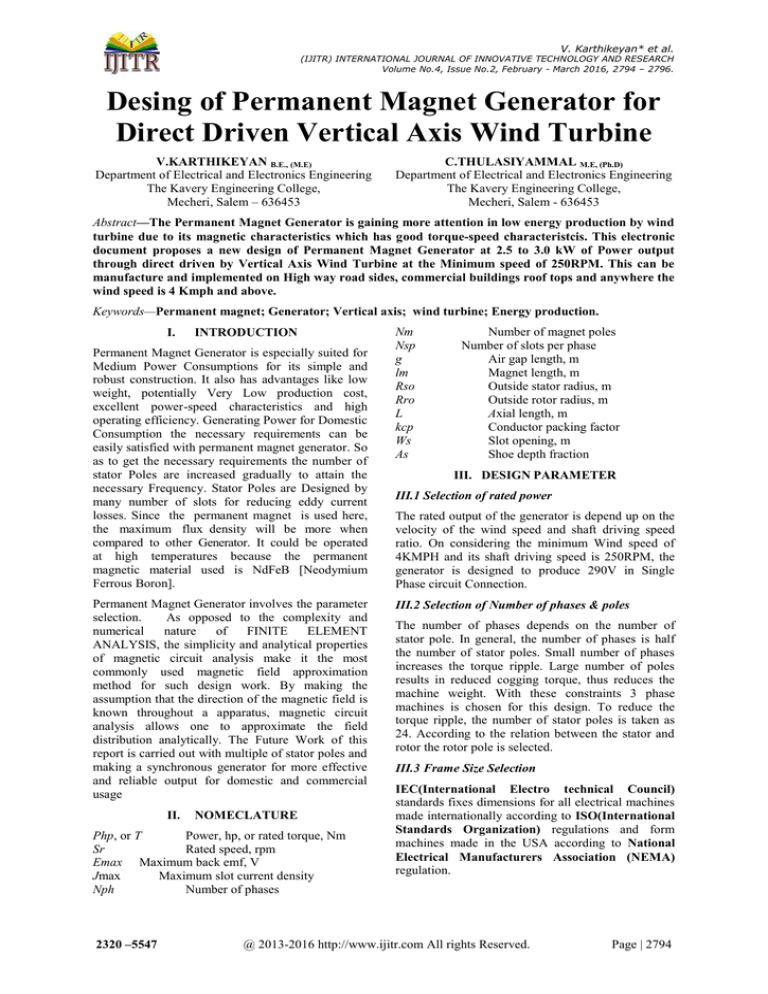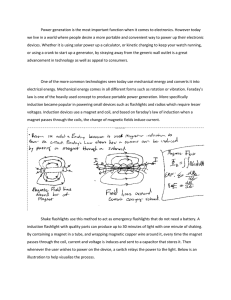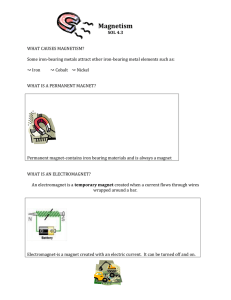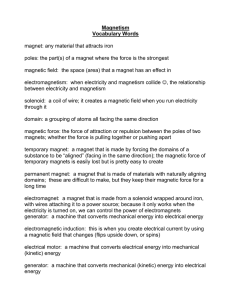
V. Karthikeyan* et al.
(IJITR) INTERNATIONAL JOURNAL OF INNOVATIVE TECHNOLOGY AND RESEARCH
Volume No.4, Issue No.2, February - March 2016, 2794 – 2796.
Desing of Permanent Magnet Generator for
Direct Driven Vertical Axis Wind Turbine
V.KARTHIKEYAN B.E., (M.E)
Department of Electrical and Electronics Engineering
The Kavery Engineering College,
Mecheri, Salem – 636453
C.THULASIYAMMAL M.E, (Ph.D)
Department of Electrical and Electronics Engineering
The Kavery Engineering College,
Mecheri, Salem - 636453
Abstract—The Permanent Magnet Generator is gaining more attention in low energy production by wind
turbine due to its magnetic characteristics which has good torque-speed characteristcis. This electronic
document proposes a new design of Permanent Magnet Generator at 2.5 to 3.0 kW of Power output
through direct driven by Vertical Axis Wind Turbine at the Minimum speed of 250RPM. This can be
manufacture and implemented on High way road sides, commercial buildings roof tops and anywhere the
wind speed is 4 Kmph and above.
Keywords—Permanent magnet; Generator; Vertical axis; wind turbine; Energy production.
I.
INTRODUCTION
Permanent Magnet Generator is especially suited for
Medium Power Consumptions for its simple and
robust construction. It also has advantages like low
weight, potentially Very Low production cost,
excellent power-speed characteristics and high
operating efficiency. Generating Power for Domestic
Consumption the necessary requirements can be
easily satisfied with permanent magnet generator. So
as to get the necessary requirements the number of
stator Poles are increased gradually to attain the
necessary Frequency. Stator Poles are Designed by
many number of slots for reducing eddy current
losses. Since the permanent magnet is used here,
the maximum flux density will be more when
compared to other Generator. It could be operated
at high temperatures because the permanent
magnetic material used is NdFeB [Neodymium
Ferrous Boron].
Permanent Magnet Generator involves the parameter
selection.
As opposed to the complexity and
numerical
nature
of
FINITE
ELEMENT
ANALYSIS, the simplicity and analytical properties
of magnetic circuit analysis make it the most
commonly used magnetic field approximation
method for such design work. By making the
assumption that the direction of the magnetic field is
known throughout a apparatus, magnetic circuit
analysis allows one to approximate the field
distribution analytically. The Future Work of this
report is carried out with multiple of stator poles and
making a synchronous generator for more effective
and reliable output for domestic and commercial
usage
II.
NOMECLATURE
Php, or T
Power, hp, or rated torque, Nm
Sr
Rated speed, rpm
Emax Maximum back emf, V
Jmax
Maximum slot current density
Nph
Number of phases
2320 –5547
Nm
Nsp
g
lm
Rso
Rro
L
kcp
Ws
As
Number of magnet poles
Number of slots per phase
Air gap length, m
Magnet length, m
Outside stator radius, m
Outside rotor radius, m
Axial length, m
Conductor packing factor
Slot opening, m
Shoe depth fraction
III. DESIGN PARAMETER
III.1 Selection of rated power
The rated output of the generator is depend up on the
velocity of the wind speed and shaft driving speed
ratio. On considering the minimum Wind speed of
4KMPH and its shaft driving speed is 250RPM, the
generator is designed to produce 290V in Single
Phase circuit Connection.
III.2 Selection of Number of phases & poles
The number of phases depends on the number of
stator pole. In general, the number of phases is half
the number of stator poles. Small number of phases
increases the torque ripple. Large number of poles
results in reduced cogging torque, thus reduces the
machine weight. With these constraints 3 phase
machines is chosen for this design. To reduce the
torque ripple, the number of stator poles is taken as
24. According to the relation between the stator and
rotor the rotor pole is selected.
III.3 Frame Size Selection
IEC(International Electro technical Council)
standards fixes dimensions for all electrical machines
made internationally according to ISO(International
Standards Organization) regulations and form
machines made in the USA according to National
Electrical Manufacturers Association (NEMA)
regulation.
@ 2013-2016 http://www.ijitr.com All rights Reserved.
Page | 2794
V. Karthikeyan* et al.
(IJITR) INTERNATIONAL JOURNAL OF INNOVATIVE TECHNOLOGY AND RESEARCH
Volume No.4, Issue No.2, February - March 2016, 2794 – 2796.
During progression of the design, if the machine size
is found to be too large or too small, different frame
size can be used. The prelim selection of frame size
automatically fixes the outer diameter of the stator
practically. Stator and Rotor Diameter ratio is 1: 16
Number of turns per phase,
e max
n s int
NmBgLRroNspp m
(8)
III.4 Selection of Air gap
Since the permanent magnet is used, there is the
probability of Cogging torque. To reduce it, 0.5 to 1.0
mm Air gap is chosen, which intends to increases the
flux density.
III.5 Specification of the Machine
Table 1: Specification of the machine
Power Rating
3 kW
Total Number of Stator poles
24
Total Number of magnet poles
8
Total Number of Phases
3
Number of Poles per phase
8
Air gap length
1 mm
Outer Diameter of Stator
160 mm
Diameter of Rotor
100 mm
Magnet length
15 mm
Back Iron length
16 mm
IV. DESIGN PROCEDURE
The material presented so far provides information
that can be used to design brushless machine. It is
only necessary to choose the correct equations,
evaluate them in the correct order, and understand the
limits of their applicability. Design refinement are
evaluated using more exact magnetization curve,
which are characteristics of flux linkage versus rotor
position and parameterized with winding current. To
facilitate this process, the required equations are
organized.
Various radii are,
Fig 1: PMG CADD model
V.
FINITE ELEMENT ANALYSIS
Finite Element Analysis (FEA) is used to predict the
torque produced at various currents and rotor
position. The following assumptions are made in
determining the magnetic field distribution inside the
machine.
a.
The outer periphery of the status stamping can
be treated as a zero magnetic vector potential
line as the magnetic field outside the status
stamping is negligible.
b.
Magnetic materials of the stator and rotor
stampings are isotropic and the magnetization
curve is single valued (hysteresis effect are
neglected).
c.
Magnetic vector potential A and current density
J have only z-directed components.
d.
Magnetic field distributions inside the Generator
are constant along the axial direction of the
Generator.
e.
End effects are neglected.
V.1 Equiflux lines
Rsb Rso bi
Rsi Rro g
Rri Rro lm bi
(1)
(2)
Equiflux lines of the Permanent Magnet Generator is
shown in [Fig 2].
(3)
Area of cross section,
d3
As d 3 Rsb tb
2
(4)
Slot width,
R
T
si
si
sd
si
s
si
e max
tb
s
tb
(5)
(6)
tb
m
i
2320 –5547
(7)
Fig 2: Flux path produced by Permanent Magnet
@ 2013-2016 http://www.ijitr.com All rights Reserved.
Page | 2795
V. Karthikeyan* et al.
(IJITR) INTERNATIONAL JOURNAL OF INNOVATIVE TECHNOLOGY AND RESEARCH
Volume No.4, Issue No.2, February - March 2016, 2794 – 2796.
V.2 Flux Density Distribution
Flux Path distribution of the Permanent Magnet
Generator is shown in [Fig 3].
Fig 7: Magnetic torque produced in Rotor
Fig 3: Flux density distributed by Permanent
Magnet
VI. GRAPHS OBTAINED FROM (FEA) FINITE
ELEMENT ANALYSIS
Fig 8: I2R Losses in Permanent Magnets
VII. CONCLUSION
Fig 4: Output Voltage of PMG
Thus a Permanent Magnet Generator is designed,
which is a trade-off design between the performance
and the cost to meet electricity demand. The output
voltage obtained at no load is 290V sine wave which
is sufficient for domestic power consumption. Since
NdFeB is rarest element, it has the capacity to
withstand in the high temperature without losing its
magnetic property. The results obtained from the
project is compared with analytical and FEA analysis.
VIII.
REFERENCE
[1]. “BAL 81 P.L.BALLANEY, Dr.S.L.UPPAL
and B.D.INDU
“Elements of Electrical and
Mechanical Engineering
Fig 5: Torque Produced by Permanent Magnet
[2]. “ AE Clayton and N N Hancock” - “The
performance and design of
Direct Current
Machines
[3]. “Brushless Permanent Magnet motor design” –
Second Edition by Dr.Duane Hanselman,
University of Maine, Orono ME 04469, USA.
[4]. “Brushless Permanent Magnet Motor Design” –
Duane C. Hanselman, University of Maine,
Orono, Maine.
[5]. “Optimal Design and Control of Axial-Flux
Brushless DC Wheel Motor For Electrical
Vehicles” – Y.P.Yang, Cheung, S.S.Wu,
National Taiwan University.
Fig 6: Flux linkage at Stator Coils
2320 –5547
[6]. “Modeling and Simulation of Sensorless Control
of PMBLDC Motor Using Zero-Crossing Back
E.M.F Detection” – R.Somanatham, P.V.N.
Prasad, A.D.Rajkumar, Osmania University,
Hyderabad.
@ 2013-2016 http://www.ijitr.com All rights Reserved.
Page | 2796



